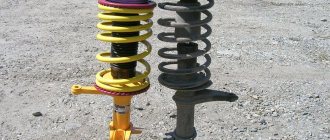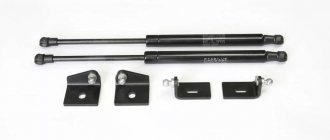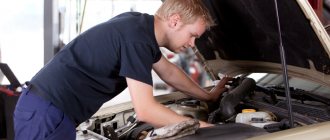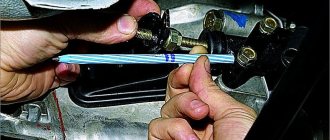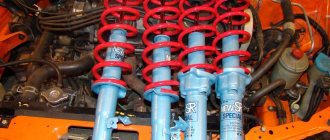Experienced motorists are fully aware of the need to bleed the shock absorber (strut) before installation. This allows you to identify defects in advance. Prolonged inactivity directly affects the condition of the oil. In addition, when storing the device in a horizontal position, shock-absorbing fluid flows. To restore normal performance, this is precisely what is required. It is important to do everything correctly, avoiding common mistakes.
Do I need to bleed shock absorbers before installation?
Gas remaining in the shock absorber, like air, is a common cause of knocks and noises during chassis operation. Therefore, it definitely needs to be pumped. If the requirement is not met, extraneous knocking and noise appears during the first ten thousand kilometers, which only intensifies over time. The suspension will begin to function with minor dips. “Death” marks jamming.
Do I need to bleed the struts before installation? Necessarily. Otherwise, the shock absorber rod, like the piston system in general, will not be able to fully perform its assigned tasks. At best, you will have to buy a new set of struts; at worst, this will lead to a traffic accident.
The shock absorber is stored in a warehouse in a horizontal position. This is due to the need to maintain the performance of the oil seals through constant contact with the lubricant. Long-term storage leads to spontaneous flow of liquid into the outer cylinder, and the freed volume is filled with air. The result is a partial loss of performance. That is why the driver needs to bleed the strut with his own hands.
Operating principle
It doesn't matter how the shock absorber is designed. All of them, regardless of type, operate on the same principle
This means that, regardless of type, they need pumping. In the shock absorber chamber, the piston performs a reciprocating movement. The piston has several holes. As the mechanism moves, the pressure in the chamber increases. By the way, it becomes larger when the car moves at low speed.
Bleeding rear shock absorbers before installation
Bleeding is an easy procedure; new shock absorbers do not need to be sent to a service center. To properly pump the device, you need to follow this sequence of actions.
- Install the stand with the stem down. The base must be solid, ideally a concrete floor.
- Smoothly compress the product.
- We fix the position for two seconds.
- To get the rod back, you need to turn the shock absorber over and pull the tube out manually. Usually the rod rises without outside help.
- Leave the rod in the extended position.
- We repeat the procedure two or three more times.
After this, the rear struts can be installed on the lever or axle of the car.
Tags
bleeding the shock absorbers before bleeding the shock absorber before pumping the shock absorbers and bleeding the shock absorbers bleeding the shock absorber front new shock absorbers not the piston of the shock absorber. bleeding the shock absorbers allows bleeding the shock absorber before bringing the shock absorber into how to bleed the shock absorber and bleed the shock absorber that bleeding the shock absorbers is necessary to bleed the shock absorber and the process of pumping shock absorbers. After bleeding the shock absorbers, the process of pumping the shock absorber. When pumping the shock absorbers, place the rod and hold the rod vertically with the rod up. The movement of the rod should turn over with the rod down and you will need to bleed new shock absorbers correctly How to bleed oil shock absorbers
down oil vases
How to bleed an oil shock absorber before installation
As mentioned earlier, everything, including oil shock absorbers, must be pre-bleeded before installation. The operating instructions supplied by the manufacturer indicate the correct sequence of actions.
- Vertical placement of the rack, the rod should be in the upper part.
- Recess the rod into the cylinder using little effort (your own weight is enough). You should leave a margin of three to four centimeters above the cut.
- Fix the device in the obtained position for four to five seconds.
- Smooth extension of the rod from the cylinder.
- Repeatedly turn the rack into a vertical position, pumping three or four times according to a similar principle.
That's all, the oil shock absorber can be installed on the car. According to my own observations, pumping automobile oil shock absorbers has the simplest principle.
Let's debunk the myth
On the eve of the step-by-step instructions for pumping, it is necessary to debunk one myth. There is a belief that a gas body vibration damper is only suitable for sports cars. The importance of high efficiency of gas workers when driving at high speed is emphasized. This is just a myth. A gas-filled shock absorber is suitable for everyone. It is installed on both family cars and station wagons. It all depends on the wishes of the car owner. But this should be within reasonable limits. It will be very funny to see a gas shock absorber on a domestic small car with a speed limit of 100 km/h.
Bleeding gas-oil shock absorbers
Bleeding automobile gas-oil shock absorbers has a different preparation technology that allows you to bring the device into working condition.
- Place the device in a vertical position, the rod must be at the bottom and must rest against a flat surface.
- By applying a little force, you need to compress the stand without jerking.
- Fixation in the obtained position for two to three seconds.
- Reversing the shock absorber. Important - under no circumstances should the rod be released for three to six seconds.
- Release of the rod.
Important!
To inflate the gas-oil struts correctly, it is necessary to repeat the procedure six to eight times. After every fourth compression-decompression stroke, a check is carried out. It is necessary to ensure that the output to the extreme position occurs without noticeable problems and delays.
Technology for pumping McPherson struts and cartridges
- Install the rack or cartridge with the rod up and smoothly, without jerking, compress it to a certain point (the working surface of the rod should not reach the top of the rack glass by 2-3 cm);
- Fix the shock absorber rod in this position for 2-3 seconds;
- Smoothly pull out the rod until it is fully extended;
- Repeat operations A, B, C 2-3 times;
- Holding the shock absorber vertically, with the rod up, perform a control operation (with sharp but short movements of the rod, make sure that the piston moves smoothly, without failures). In well-pumped shock absorbers, the piston moves smoothly without dips (please note that in some shock absorbers, when fully decompressed, the valve mechanism may enter the compensation cavity, designed to expand the shock-absorbing fluid when warmed up, and not provide any resistance).
Based on materials from the site: https://www.kybcom.ru/prokachka.html
How to pump up struts with your own hands that were already on the car
If over time the car begins to behave on the road differently than before, it is necessary to check the condition of the suspension. To do this, the strut is removed from the spring and then checked. Used copies also need pumping, even if the seller assures that everything is fine with them and they do not need additional manipulations.
The principle of performing the work remains the same. But the main attention is paid to the behavior of the rod when returning to its original position. If even after 6-8 up and down movements the rack works in the same way, this indicates its severe wear. There is no need to install it on a car. There are two options - buying a new set, or handing it over to a specialist for restoration.
Existing types and their features
In general, a shock absorber is a special spring that accumulates energy during compression. Such devices can be divided into several types (based on technical characteristics):
- Hydraulic two-pipe.
- Gas-hydraulic single-pipe, high pressure.
- Gas-hydraulic two-pipe, on the contrary, low pressure.
The way any of the above parts work is based on converting the energy coming from the suspension into thermal power. Thanks to this transformation, the shock absorbers prevent excessive natural movement of the car. This is how travel comfort and long vehicle life are ensured.
Conventional technology can work for several long years, although the first signs of wear are noticeable after a run of 30 thousand kilometers. By the way, the larger the dimensions of your car, the more noticeable such damage will be. If you have a very powerful engine, then it is best to install a double shock absorber.
What happens if you don’t bleed the shock absorber before installation?
The procedure discussed is necessary to put the shock absorber strut into working condition. This provides:
- comprehensive removal of residual lubricant or air from the space of the inner sleeve. Failure to follow this procedure will lead to failure of the shock absorber unit after 10-15 thousand kilometers (sometimes earlier);
- early detection of defects and potential malfunctions in box shock absorbers, expressed in the form of sticking of the valve block.
Note! According to the experts who service the suspension at service centers, it is enough to pump the unpacked shock absorber three times. In their opinion, a one-time pumping is not enough to bring the part back to life.
When installing a new shock absorber without preliminary pumping, after 3-5 thousand kilometers, an incomprehensible noise and knocking will occur. After another 5-7 thousand kilometers the strut will jam. It is unlikely that it will be possible to return it to good condition.
Let us inform inexperienced drivers: only twin-tube shock absorbers require bleeding. The exception is a single-pipe new copy. The operating principle is designed so that the oil does not enter the gas chamber, because the latter is under high pressure. The result is that excess air cannot accumulate. A sealed piston is responsible for this, separating the two media from each other.
If you accidentally pump a single-pipe product, it will not damage it. Young owners who do not understand the difference between a single-pipe and a two-pipe device should still do control pumping. On the one hand, this will not harm the single-pipe design. On the other hand, this will take at most five minutes of free time, and it will be possible to avoid potential malfunctions in the future.
Bleeding is a simple procedure that does not require contacting a service station technician. By following the rules, the device will last its entire operational life.
What is the difference between gas-oil products and oil products?
From the name itself it is already clear that their main difference is the working composition that is used inside the device.
In oil shock absorbers, the working space is filled with hydraulic oil.
The main disadvantage of these types of devices is aeration (oil foaming), which occurs as a result of changes in the physicochemical properties of the liquid when a piston acts on it in a small space.
This is manifested by a failure in the operation of the device and uncharacteristic sounds.
A partial reduction in aeration is achieved by replacing air with nitrogen gas; as a result, gas-oil analogues have appeared, which come in one or two pipes.
Single-pipe ones are often called gas ones, because there the oil and gas are separated by a movable jumper and do not mix.
IMPORTANT TO KNOW: Causes of shock absorber knocking.
Strong backpressure ensures gas pressure in the region of 10 - 30 atmospheres; there are also regulated analogues. Mainly installed on sports cars.
Twin-pipe gas-oil shock absorbers have less gas pressure - from 3 to 10 atmospheres.
But he won’t delve into the topic, because that’s not what you came here for. The shock absorber structure can be seen in the photo below.
How to do everything right
You can work with different types of shock absorbers, including collapsible, non-separable, front, rear, two-tube or single-tube options. To properly pump shock absorbers you do not need expensive stands or complex tools. It is enough to have gloves that can protect against dirt and injuries.
Some shock absorbers will have to be drained of oil to replace it with new one. After pumping, it will be necessary to maintain the vertical condition of the products before installation. Otherwise, there is a risk of air getting inside again.
Draining the oil is done in different ways. One option involves lowering the piston down, leaving a power reserve of about 3 cm. There is also a special groove in the upper part through which the drain is carried out.
Varieties
If a car enthusiast knows what shock absorbers he knows, then we will get something like this: oil, gas-oil and gas. This answer is partially correct. It is more correct to divide into two types: oil and gas.
This division is based on the use of different working substances. Gas shock absorbers use an inert gas, most often nitrogen, pumped under high pressure. In oil shock absorber struts, hydraulic oil and air or gas are pumped into the working space.
Structurally, they are divided into two types: two-pipe and single-pipe.
The first type of shock-absorbing struts is the most common due to its simplicity and low cost of manufacture. Oil or gas and oil are used as the working substance. The main disadvantage of oil shock absorbers is poor cooling of the working substance. The oil gets very hot due to its small working volume. High temperatures cause the oil to foam and the shock absorber stops working correctly.
Shock absorbers are structurally made into two-pipe and single-pipe. Oil and gas are pumped into the middle
Gas-oil shock absorber struts are partially free of this drawback. Oil and air are pumped into a two-pipe housing under a pressure of 2–3 atmospheres. Sometimes nitrogen is used instead of air. This solution reduces the likelihood of aeration - foaming of the oil.
This is interesting: Apple has taught iOS 7 to connect to machines
Structurally, monotube shock absorbers do not have a working chamber. It is replaced by the rack housing. The tube is divided into two sections. The upper part is filled with oil, and the lower part is filled with high pressure gas. There is a valve between the sections.
Gas shock absorbers are of particular interest to drivers. This is no accident. Gas struts are primarily used in motorsports. For sports driving, this type of rack is most often chosen. The operation of the gas shock absorber is ensured by pumped gas under high pressure. Such racks are the toughest and driving on city roads is accompanied by shocks and impacts. Such a ride cannot be called comfortable, but driving will be clear and controlled. Therefore, gas shock absorber struts are used mainly on racing cars.
A special type of shock absorbers are the so-called “reversals”. They were given this name not because they can be placed upside down. In such racks, the reverse position of the rod is used. In conventional shock absorbers, the rod is directed upward. In inversions, the rod is directed downwards and is attached to the shock-absorbing strut body. There is a pseudo-rod on top. It looks much thicker. The operation of the inverted shock absorber is ensured by several plain bearings. This design reduces the vertical and lateral load on the rack.



